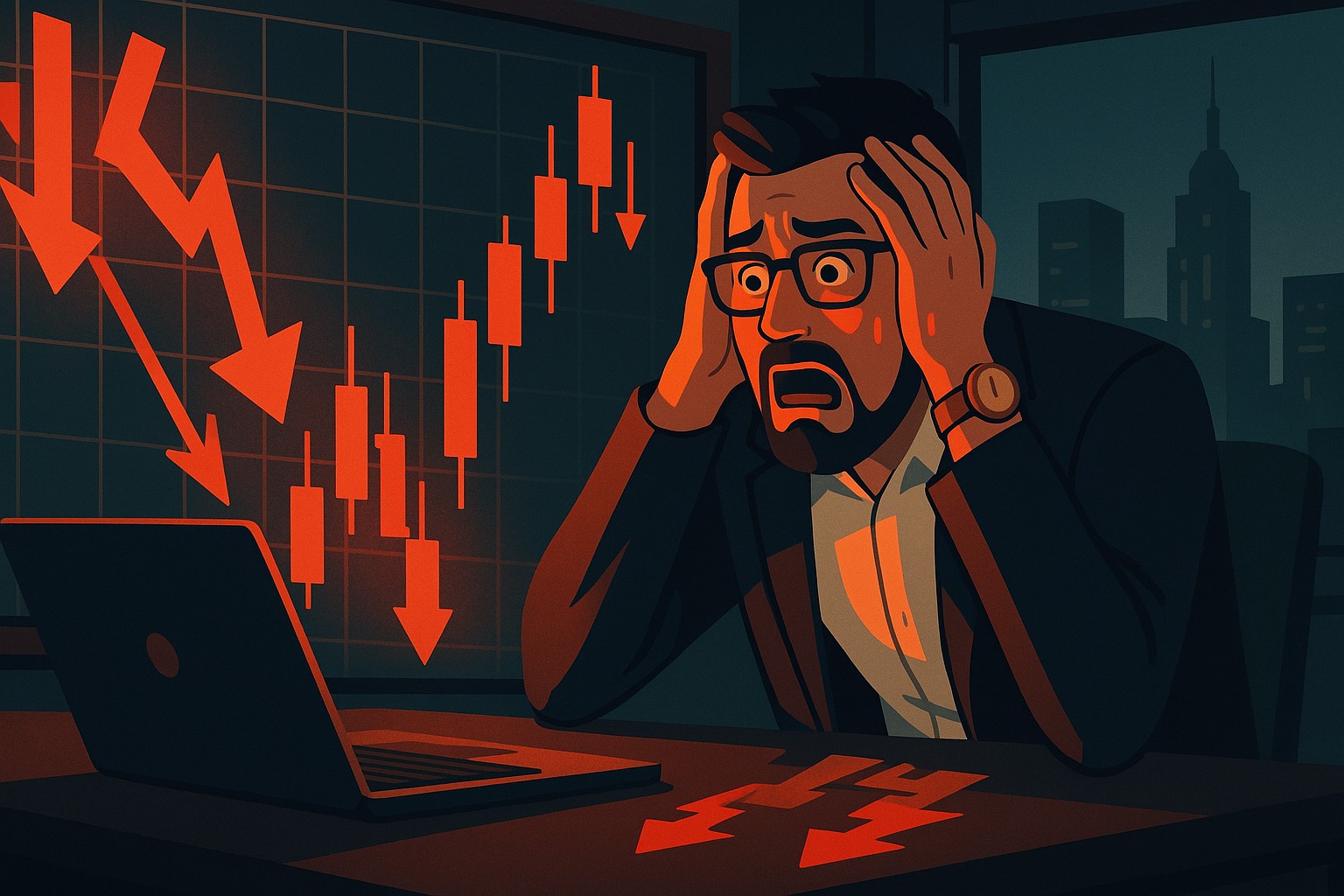Cost Averaging vs. Martingale Strategy: Why You Should Add to Winners, Not Losers
2025-09-12 09:38:32
Let’s be honest. At some point, you’ve probably felt the urge to add to a losing trade. Maybe you told yourself: “If I buy more down here, my average price improves… I just need a small bounce, and I’m out green.”
That urge is common, and it’s exactly why so many retail traders repeat the same mistakes. If you haven’t yet, read why most traders fail - not because they lack setups, but because of behavior and risk choices that sabotage otherwise decent ideas: Why 90% of Retail Traders Fail Even with Profitable Trading Strategies.
Sound familiar? You’re not alone. This is one of the most common traps traders fall into, and it’s not just about bad math - it’s about how your brain is wired.
If you want the bigger picture of how to think like a price-action trader instead of reacting to pain, this is a useful primer: How to Think Like a Price Action Trader.
Before we dive into Cost Averaging and the Martingale Strategy, let’s talk about why traders do this in the first place.
Why Do Traders Add to Losers?

When you take a loss, your brain screams for relief. It doesn’t want to accept pain; it wants to “fix” the situation. That’s why averaging down feels so tempting - it gives you the illusion that you’re in control, that you’re one step closer to getting back to breakeven.
If you’ve ever been stopped out right before the market reversed and then chased back in, you’ve tasted the psychology behind liquidity traps: Outsmarting Stop Hunts: The Psychology Behind the Trap.
But here’s the kicker: every time you add to a loser, your brain releases a small hit of dopamine. It’s the same chemical rush gamblers get pulling the lever on a slot machine.
- You lose → pain.
- You add more → hope.
- Price ticks slightly in your favor → dopamine reward.
That loop is addictive. And it’s why so many traders keep digging deeper into losing trades until the account blows. If this resonates, build guardrails now - start here: Top 10 Ways to Prevent Emotional Trading and Stay Disciplined and reinforce it with daily routines that protect your edge: The Daily Habits of Profitable Traders.
So the real question is: how do you break the loop? That’s where understanding Cost Averaging and Martingale comes in.
What Exactly Is Cost Averaging?
You’ve probably heard of Dollar-Cost Averaging in investing - buying a fixed amount of an asset at regular intervals, no matter the price. Traders adapt this idea by scaling into positions with smaller entries instead of going “all-in” on one price. When you do apply it as a trader, make sure it’s rooted in structure - key levels, session behavior, and multi-timeframe alignment:
- Levels: Mastering Price Action at Key Levels
- Timeframes: The Power of Multi-Timeframe Analysis in SMC
It sounds smart, right? Spread your entries, smooth your risk, and avoid obsessing over the perfect entry point. And yes - when done correctly, it can be.
But here’s the catch: if you cost average blindly, without confirmation, you’re basically doing Martingale in slow motion. You’re still adding to losers, just in smaller bites. If you want a clean way to avoid that trap, wait for retests and confirmation instead of “buying the dip” on hope: Mastering Retests: Enter with Confirmation After a Breakout.
That’s why cost averaging is a double-edged sword. With structure, it’s useful. Without it, it’s just another way to justify bad behavior.
So, What’s the Martingale Strategy?
Martingale comes straight out of 18th-century gambling halls. The idea was simple: every time you lose, double your bet. Eventually, a win will come, and it’ll cover all the losses plus give you profit equal to your first wager.
Traders borrowed this system. Let’s say you go long, price drops, you add double. It drops again, you add double again. The hope is that when it finally bounces, you’re back in profit.
In theory, it looks clever. In reality? It’s Russian roulette with your account. If the market trends longer than your balance can handle, it’s game over. For a deeper dive into why this “works until it doesn’t,” read: Martingale Strategy in Trading: Compounding Power or Double-Edged Sword?
That’s why Martingale isn’t really a strategy - it’s a gamble disguised as math.
Cost Averaging vs. Martingale
Here’s how they stack up:
| Aspect | Cost Averaging | Martingale |
|---|---|---|
| Philosophy | Build gradually at planned levels | Double down after losses |
| Focus | Smooth entries (if confirmed) | Recover losses |
| Risk Profile | Controlled if disciplined | Explodes exponentially |
| Psychology | Patience, structure | Dopamine-driven hope |
| Outcome | Useful with confirmation | Account blow-up waiting to happen |
But notice something important: both can go wrong if you’re adding to losers without a plan. Which is why the shift you’re about to see matters so much.
The Smarter Shift: Add to Winners, Not Losers

Here’s the mindset that separates professionals from gamblers: don’t build bigger positions when you’re wrong. Build them when you’re right.
This approach is often called Anti-Martingale or pyramiding.
Instead of digging deeper into a bad trade, you stack into a good one. If you want a simple breakdown of how to structure that around the open, start here: How To Trade & Scalp Indices at the Open Using SMC.
Think of it this way:
- Wrong trade? You cut it fast.
- Right trade? You add as the market confirms your bias (classic breakout + retest logic: How to Trade Breakouts Effectively).
That way, your biggest exposure only happens when you’re already in profit - not when you’re trying to rescue a sinking ship. And yes, that still lives under the umbrella of risk math you can’t ignore: Risk of Ruin in Trading.
Why Adding to Winners Feels So Hard

Here’s the twist: adding to losers feels safe. You’re convinced you’re getting a better price. Adding to winners, on the other hand, feels scary. You’re worried about giving back profit or getting “top-ticked.”
But feelings aren’t facts. Adding to losers is where accounts die. Adding to winners - done with structure - is where accounts grow. To retrain that instinct, solidify identity-based rules and routines: Identity-Based Trading: Become Your System and pair it with a daily process: The Daily Habits of Profitable Traders.
You need to retrain it.
How to Add to Winners Without Blowing Up
Alright, so how do you actually do it? Here’s a framework:
Plan Your Scaling Levels
Only add after confirmation - breaks of structure, retests, or clear continuation setups.
If you need a walkthrough on confirmation logic, this helps: Mastering Retests.
Make Each Add Smaller
First add might be 1 lot, second 0.7, third 0.5. This keeps your pyramid balanced.
For broader context on managing trend participation, revisit: Moving Averages Trading Strategy Playbook.
Protect Earlier Entries
As you add, move previous stops to breakeven or into profit. You’re now playing with “house money.” Execution discipline matters more than the setup: The Mental Game of Execution.
Cap Your Total Risk
Decide upfront: maybe 2%–3% max on the entire idea. No exceptions. If you’re unsure how much to risk, bookmark this trio:
- Mastering Risk Management: SL/TP/Position Sizing
- How Much Should You Risk per Trade?
- The Ultimate Guide to Risk Management (2025 Compilation)
Know When to Stop
If momentum slows or structure fails, stop stacking. And if you’re stepping up size as you win, do it methodically, not emotionally: Scaling in Trading: When & How to Increase Lot Sizes.
A Quick Example
Picture this: you’re trading NASDAQ during the New York open. If you’re new to that session’s personality, this is a great scene-setter: Mastering the New York Session – SMC Guide.
- First entry: Long after a liquidity sweep and bullish structure break. Risk = 1%.
- Second entry: Price rallies in your favor, pulls back, you add 0.7%. First entry stop is now breakeven.
- Third entry: Another breakout and retest shows strength, you add 0.5%.
Total risk never exceeds ~2%, but your position grows stronger as the market confirms your idea. That’s the essence of adding to winners. If you prefer a different vehicle, the logic maps to gold trading as well - see the full playbook: Complete Step-by-Step Guide to Day Trading Gold (SMC).
Real-Life Analogy: Climbing a Mountain

Here’s how I want you to picture it:
- Martingale: climbing down a ladder that’s breaking rung by rung. You keep stepping harder, hoping the next one holds. Eventually, the ladder collapses.
- Blind Cost Averaging: walking up a mountain but adding heavy rocks to your backpack on loose ground. One slip, and you tumble.
- Adding to Winners: climbing with ropes and anchors. Every step is secured before you add more weight. Even if one step slips, you don’t fall all the way back.
Which climber would you rather be? If your answer is the one with anchors, make sure your anchors are real risk rules, not wishful thinking: Why Risk Management Is the Only Edge That Lasts.
Final Thoughts

Both cost averaging and Martingale involve scaling, but only one has the potential to keep you in the game - and even then, only if done with confirmation.
- Martingale? A blow-up waiting to happen.
- Blind cost averaging? Not much safer. Use retests and structure to avoid becoming a slow-motion Martingale (confirmation guide).
- Adding to winners with structure? That’s where growth happens.
So here’s your takeaway:
Don’t add to losers. Add to winners. Train yourself to feel that dopamine kick not when you average down, but when you pyramid a trade that’s already paying you.
Start Practicing with Confidence - Risk-Free!
- Trade forex, indices, gold, and more
- Access ACY, MT4, MT5, & Copy Trading Platforms
- Practice with zero risk
It’s time to go from theory to execution - risk-free.
Create an Account. Start Your Free Demo!
Check Out My Contents:
Strategies That You Can Use
Looking for step-by-step approaches you can plug straight into the charts? Start here:
- How To Trade & Scalp Indices at the Open Using Smart Money Concepts (SMC)
- How to Trade Breakouts Effectively in Day Trading with Smart Money Concepts
- Complete Step-by-Step Guide to Day Trading Gold (XAU/USD) with Smart Money Concepts (SMC)
- The Power of Multi-Timeframe Analysis in Smart Money Concepts (SMC)
- Forex Trading Strategy for Beginners
- Mastering Candlestick Pattern Analysis with the SMC Strategy for Day Trading
- How to Use Fibonacci to Set Targets & Stops (Complete Guide)
- RSI Divergence Trading Strategy for Gold: How to Identify and Trade Trend Reversals
- Stochastics Trading Secrets: How to Time Entries in Trending Markets using Stochastics
- Gold Trading Stochastics Strategy: How to Trade Gold with 2R - 3R Targets
- RSI Hidden Divergence Explained: How to Spot Trend Continuations Like a Pro
- Moving Averages Trading Strategy Playbook
- Mastering Fibonacci Trading Psychology - Trusting the Levels, Managing the Mind
- Mastering Price Action at Key Levels - How to Spot, Trade, and Win at the Most Crucial Zones
- Mastering Retests: How to Enter with Confirmation After a Breakout
Indicators / Tools for Trading
Sharpen your edge with proven tools and frameworks:
- The Ultimate Guide to Risk Management in Trading - A Complete Compilation for 2025
- Moving Averages Trading Strategy Playbook
- How to Think Like a Price Action Trader
- Mastering Fibonacci Trading Psychology - Trusting the Levels, Managing the Mind
How To Trade News
News moves markets fast. Learn how to keep pace with SMC-based playbooks:
- Why Smart Money Concepts Work in News-Driven Markets - CPI, NFP, and More
- How to Trade NFP Using Smart Money Concepts (SMC)-A Proven Strategy for Forex Traders
- How to Trade CPI Like Smart Money - A Step-by-Step Guide Using SMC
Learn How to Trade US Indices
From NASDAQ opens to DAX trends, here’s how to approach indices like a pro:
- How to Start Trading Indices and Get into the Stock Market with Low Capital (2025 Guide)
- Best Indices to Trade for Day Traders | NASDAQ, S&P 500, DAX + Best Times to Trade Them
- How To Trade & Scalp Indices at the Open Using Smart Money Concepts (SMC)
- NAS100 - How to Trade the Nasdaq Like a Pro (Smart Money Edition)
How to Start Trading Gold
Gold remains one of the most traded assets - - here’s how to approach it with confidence:
- How to Swing Trade Gold (XAU/USD) Using Smart Money Concepts: A Simple Guide for Traders
- Complete Step-by-Step Guide to Day Trading Gold (XAU/USD) with Smart Money Concepts (SMC)
- The Ultimate Guide to Backtesting and Trading Gold (XAU/USD) Using Smart Money Concepts (SMC)
- Why Gold Remains the Ultimate Security in a Shifting World
- How to Exit & Take Profits in Trading Gold Like a Pro: Using RSI, Range Breakdowns, and MAs as Your Confluence
How to Trade Japanese Candlesticks
Candlesticks are the building blocks of price action. Master the most powerful ones:
- Mastering the Top Japanese Candlesticks: The Top 5 Candlesticks To Trade + Top SMC Candlestick Pattern
- How to Trade Candlestick Patterns with High Probability: A Complete Guide for Beginners
- The Top Japanese Candlestick Guide: What is an Engulfing Pattern and How to Trade It?
- Piercing Pattern Candlestick Explained: How to Trade It - Step-By-Step Guide
- Morning & Evening Star Candlestick Patterns - How to Trade Market Reversals with Confidence
How to Start Day Trading
Ready to go intraday? Here’s how to build consistency step by step:
- 5 Steps to Start Day Trading: A Strategic Guide for Beginners
- 8 Steps How to Start Forex Day Trading in 2025: A Beginner’s Step-by-Step Guide
- 3 Steps to Build a Trading Routine for Consistency and Discipline - Day Trading Edition
- The Ultimate Guide to Understanding Market Trends and Price Action
- Trading with Momentum: The Best Trading Session to Trade Forex, Gold and Indices
Learn how to navigate yourself in times of turmoil
Markets swing between calm and chaos. Learn to read risk-on vs risk-off like a pro:
- How to Identify Risk-On and Risk-Off Market Sentiment: A Complete Trader’s Guide
- How to Trade Risk-On and Risk-Off Sentiment - With Technical Confirmation
- The Ultimate Guide to Understanding Market Trends and Price Action
Want to learn how to trade like the Smart Money?
Step inside the playbook of institutional traders with SMC concepts explained:
- Why Smart Money Concepts Work: The Truth Behind Liquidity and Price Action
- Mastering the Market with Smart Money Concepts: 5 Strategic Approaches
- Understanding Liquidity Sweep: How Smart Money Trades Liquidity Zones in Forex, Gold, US Indices
- The SMC Playbook Series Part 1: What Moves the Markets? Key Drivers Behind Forex, Gold & Stock Indices
- The SMC Playbook Series Part 2: How to Spot Liquidity Pools in Trading-Internal vs External Liquidity Explained
- Fair Value Gaps Explained: How Smart Money Leaves Footprints in the Market
- Accumulation, Manipulation, Distribution: The Hidden Cycle That Runs Every Market
- Institutional Order Flow - Reading the Market Through the Eyes of the Big Players
- London Session Trading Secrets: How Smart Money Sets the High & Low of the Day
- Mastering the New York Session - Smart Money Concepts Guide
Master the World’s Most Popular Forex Pairs
Forex pairs aren’t created equal - - some are stable, some are volatile, others tied to commodities or sessions.
- The Top 5 All-Time Best Forex Pairs to Trade
- Top Forex Pairs Beyond the Big Five
- EUR/USD: The King of Forex
- USD/JPY: The Fast Mover
- GBP/USD: The Volatile Cable
- AUD/USD: The Commodity Currency
- USD/CAD: The Oil-Backed Pair
- GBP/JPY: How to Trade The Beast
- Asian & London Session Secrets
- Mastering the New York Session
Stop Hunting 101
If you’ve ever been stopped out right before the market reverses - - this is why:
- Stop Hunting 101: How Swing Highs and Lows Become Liquidity Traps
- Outsmarting Stop Hunts: The Psychology Behind the Trap
- How to Lessen Risk From Stop Hunts in Trading
- How Stop Hunts Trigger Revenge Trading - Breaking the Pain Cycle
- How to Accept Stop Hunts Without Losing Discipline - Shifting From Frustration to Focus
Trading Psychology
Mindset is the deciding factor between growth and blowups. Explore these essentials:
- The Mental Game of Execution - Debunking the Common Trading Psychology
- Managing Trading Losses: Why You Can Be Wrong and Still Win Big in Trading
- The Hidden Threat in Trading: How Performance Anxiety Sabotages Your Edge
- Why 90% of Retail Traders Fail Even with Profitable Trading Strategies
- Top 10 Habits Profitable Traders Follow Daily to Stay Consistent
- Top 10 Trading Rules of the Most Successful Traders
- Top 10 Ways to Prevent Emotional Trading and Stay Disciplined in the Markets
- Why Most Traders Fail - Trading Psychology & The Hidden Mental Game
- Emotional Awareness in Trading - Naming Your Triggers
- Discipline vs. Impulse in Trading - Step-by Step Guide How to Build Control
- Trading Journal & Reflection - The Trader’s Mirror
- Overcoming FOMO & Revenge Trading in Forex - Why Patience Pays
- Risk of Ruin in Trading - Respect the Math of Survival
- Identity-Based Trading: Become Your Trading System for Consistency
- Trading Psychology: Aligning Emotions with Your System
- Mastering Fear in Trading: Turn Doubt into a Protective Signal
- Mastering Greed in Trading: Turn Ambition into Controlled Growth
- Mastering Boredom in Trading: From Restless Clicking to Patient Precision
- Mastering Doubt in Trading: Building Confidence Through Backtesting and Pattern Recognition
- Mastering Impatience in Trading: Turn Patience Into Profit
- Mastering Frustration in Trading: Turning Losses Into Lessons
- Mastering Hope in Trading: Replacing Denial With Discipline
- When to Quit on Trading - Read This!
- The Math of Compounding in Trading
- Why Daily Wins Matter More Than Big Wins
- Scaling in Trading: When & How to Increase Lot Sizes
- Why Patience in Trading Fuels the Compounding Growth
- Step-by-Step Guide on How to Manage Losses for Compounding Growth
- The Daily Habits of Profitable Traders: Building Your Compounding Routine
Risk Management
The real edge in trading isn’t strategy - it’s how you protect your capital:
- Mastering Risk Management: Stop Loss, Take Profit, and Position Sizing
- Why Risk Management Is the Only Edge That Lasts
- How Much Should You Risk per Trade? (1%, 2%, or Less?)
- The Ultimate Risk Management Plan for Prop Firm Traders - Updated 2025
- Mastering Position Sizing: Automate or Calculate Your Risk Like a Pro
- Martingale Strategy in Trading: Compounding Power or Double-Edged Sword?
Suggested Learning Path
If you’re not sure where to start, follow this roadmap:
- Start with Trading Psychology → Build the mindset first.
- Move into Risk Management → Learn how to protect capital.
- Explore Strategies & Tools → Candlesticks, Fibonacci, MAs, Indicators.
- Apply to Assets → Gold, Indices, Forex sessions.
- Advance to Smart Money Concepts (SMC) → Learn how institutions trade.
- Specialize → Stop Hunts, News Trading, Turmoil Navigation.
This way, you’ll grow from foundation → application → mastery, instead of jumping around randomly.
Follow me for more daily market insights!
Jasper Osita - LinkedIn - FXStreet - YouTube
This content may have been written by a third party. ACY makes no representation or warranty and assumes no liability as to the accuracy or completeness of the information provided, nor any loss arising from any investment based on a recommendation, forecast or other information supplies by any third-party. This content is information only, and does not constitute financial, investment or other advice on which you can rely.
Try These Next
4 Powerful Tactics to Overcome the Most Costly Forex Mistakes
How to Master MT4 & MT5 - Tips and Tricks for Traders
The Importance of Fundamental Analysis in Forex Trading
Forex Leverage Explained: Mastering Forex Leverage in Trading & Controlling Margin
The Importance of Liquidity in Forex: A Beginner's Guide
Close All Metatrader Script: Maximise Your Trading Efficiency and Reduce Stress
Best Currency Pairs To Trade in 2025
Forex Trading Hours: Finding the Best Times to Trade FX
MetaTrader Expert Advisor - The Benefits of Algorithmic Trading and Forex EAs
Top 5 Candlestick Trading Formations Every Trader Must Know















